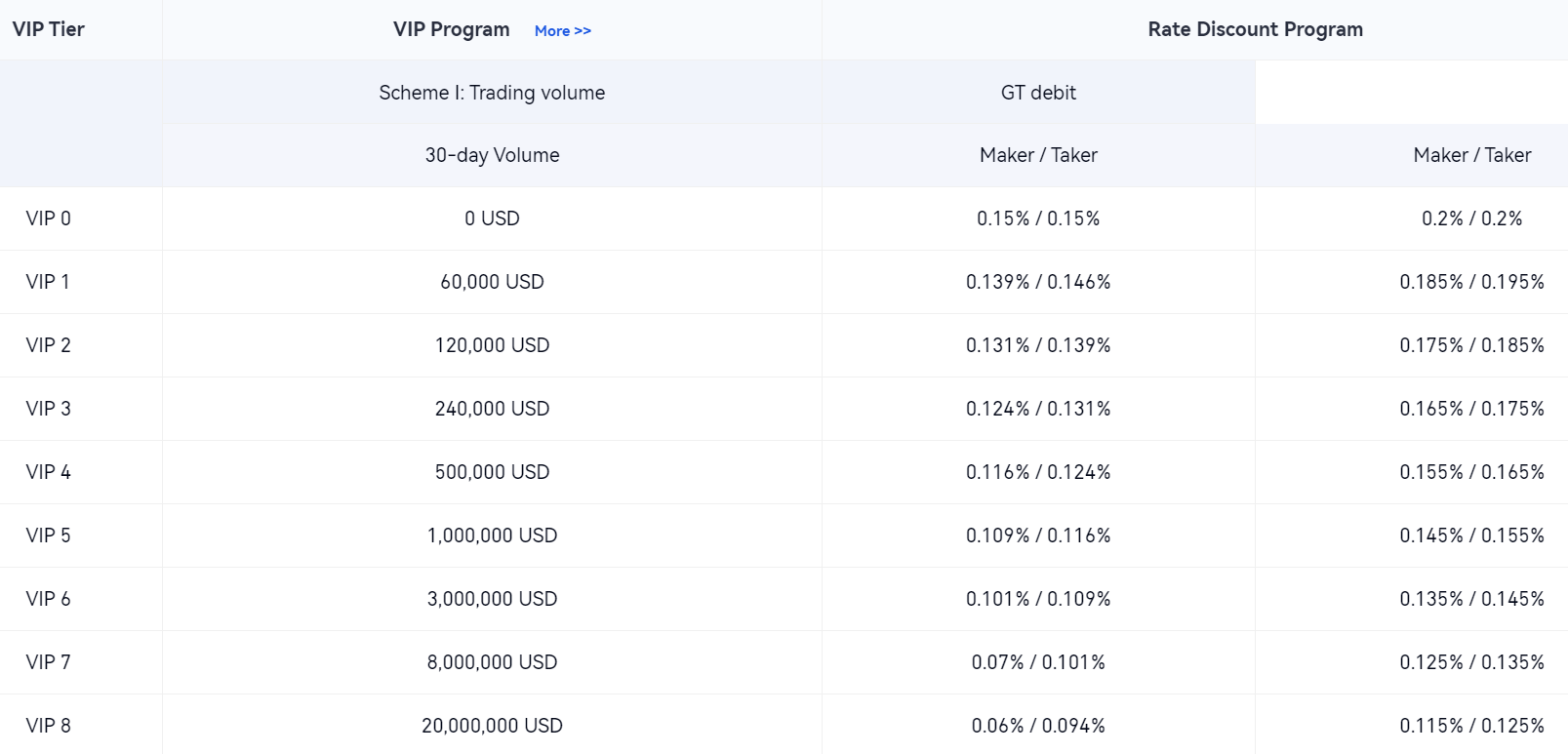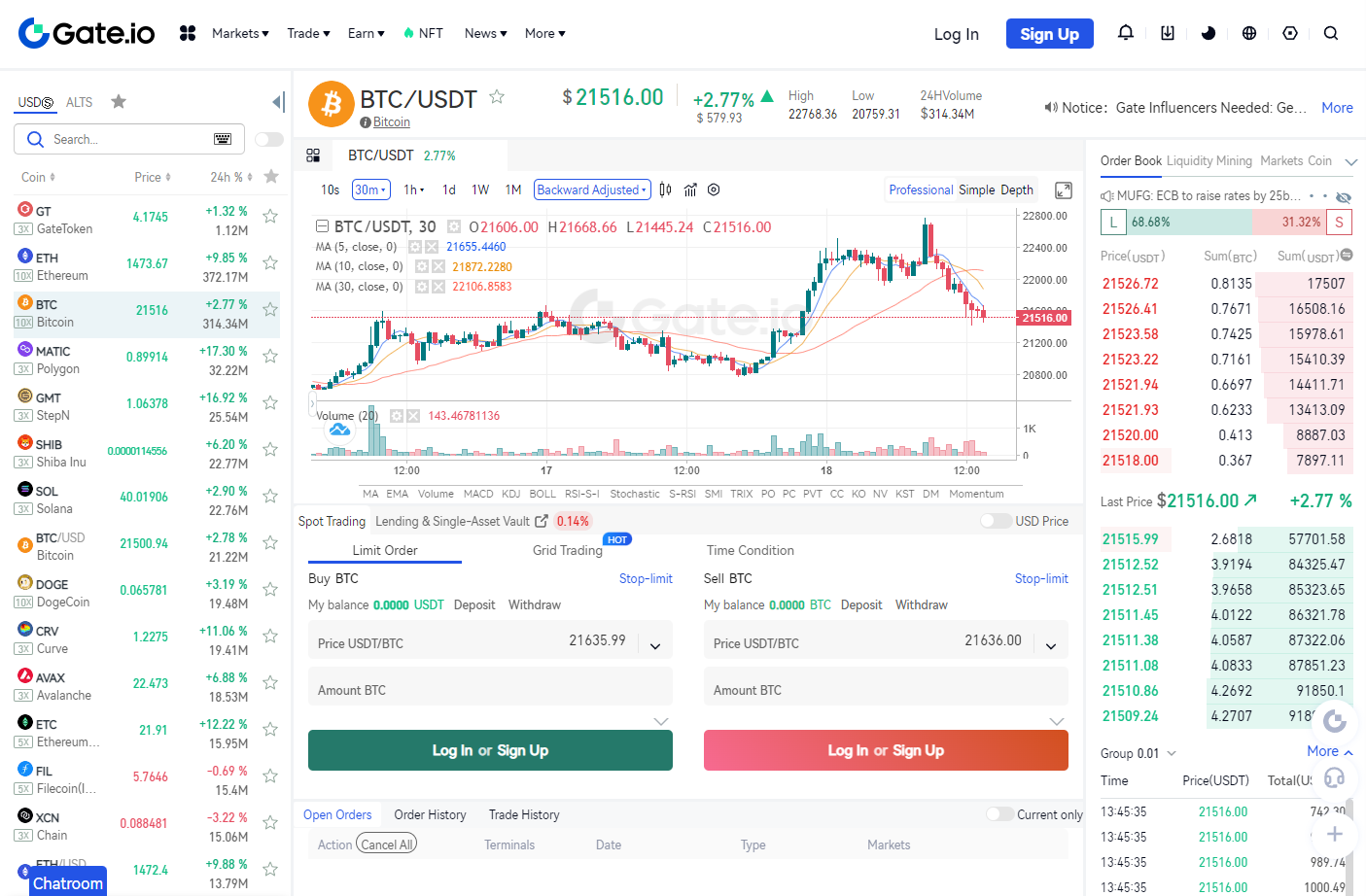Gate.io and BitMart are among the giants in the crypto trading landscape, and I’ve had the privilege of exploring both in-depth.
From user-friendly interfaces to an extensive array of supported cryptocurrencies, each platform has its strong suits.
But which one is better?
In this article, I’ll be breaking down the essentials of Gate.io and BitMart, comparing them on grounds such as trading fees, security, customer support, and more.
You’ll have a clear winner for your specific needs by the end!
Gate.io vs BitMart: At A Glance Comparison
| Criteria | Gate.io | BitMart |
| Supported Cryptocurrencies | Over 800+ | Over 350+ |
| Trading Fee | 0.2% for both maker and taker | 0.25% for both maker and taker |
| Supported Countries | Nearly Global | Nearly Global |
| Fiat Trading | Yes | Yes |
| Security Features | Two-factor authentication, withdrawal whitelist | Two-factor authentication, withdrawal whitelist |
| Customer Support | 24/7 via email and live chat | 24/7 via email and live chat |
Based purely on this head-to-head comparison, Gate.io seems to take the upper hand due to its lower trading fee and a more comprehensive array of supported cryptocurrencies.
The devil is in the detail, and we have a long way to go.
Gate.io vs BitMart: Trading Markets, Products & Leverage Offered
Let’s get into the thick of it, shall we?
Regarding trading markets and products, Gate.io boasts a diversified portfolio.
They offer spot trading, margin trading, Futures trading, and even Options trading for the more adventurous traders.
And if you’re thinking about leverage, Gate.io provides up to 10x leverage on certain trading pairs, which can truly help you maximize your potential profits.
BitMart also offers a fair share of trading options, including spot and Futures trading.
However, they fall short as Options trading is missing from their line-up.
As for leverage, BitMart offers up to 20x on Futures trading, a significant plus for traders looking to amp up their game.
So, who gets the crown?
Although BitMart offers higher leverage, Gate.io takes this round due to its diversified range of trading products, which can cater to a wider range of traders.
But remember, this is just one aspect of the comparison.
Stay tuned as we delve further into the duel between Gate.io and BitMart.
Gate.io vs BitMart: Supported Cryptocurrencies
Gate.io supports an impressive array of over 700 cryptocurrencies.
From Bitcoin and Ethereum to lesser-known altcoins, Gate.io has got you covered.
But hold on to your seats because BitMart is not far behind.
With support for over 600 cryptocurrencies, BitMart offers a vast ocean of trading possibilities.
So, who takes the lead here?
It’s a close call, but Gate.io wins this round with its slightly larger selection of cryptocurrencies.
However, it’s important to note that both exchanges offer a commendable variety, providing traders with plenty of options.
Stay tuned as we continue to dissect these platforms head-to-head.
Gate.io vs BitMart: Trading Fee & Deposit/Withdrawal Fee Compared
Gate.io operates on a maker-taker fee model, with fees ranging from 0.2% to as low as 0.06% for high-volume traders.
But let’s not jump to conclusions yet!
BitMart, on the other hand, has a slightly more appealing fee structure.
With a flat trading fee of 0.1%, it undercuts Gate.io for most traders, especially those with lower trading volumes.
The story doesn’t end here, though.
Regarding deposit and withdrawal fees, both crypto leverage exchanges have their ups and downs, largely depending on the specific crypto.
In the final analysis, while Gate.io might appeal to high-volume traders with its tiered fee structure, BitMart steals the show for the average trader with its lower flat trading fee.
Read on as we unpack more differences between these two formidable crypto exchanges.
Gate.io vs BitMart: Order Types
Here we go. Let’s talk about flexibility in trading strategies.
Gate.io and BitMart offer various order types, but how do they stack up?
At Gate.io, you’re not left wanting options.
With order types like limit, market, stop limit, and even more advanced orders such as scaled and iceberg orders, it offers plenty of room for strategic maneuvers.
Now, isn’t that impressive?
However, BitMart is no slouch, either.
While it doesn’t boast the extensive list that Gate.io does, it covers the basics solidly, with market, limit, and stop-limit orders at your disposal.
If variety is the spice of life, then Gate.io seems to be packing more heat in this category.
However, BitMart may be enough for traders who prefer simplicity over many options.
Stick around as we dig into more facets of these platforms!
Gate.io vs BitMart: KYC Requirements & KYC Limits
Gate.io has a relatively straightforward KYC process.
They require your ID, proof of address, and a selfie.
The platform has limits for non-verified users, but once you’re verified, these restrictions lift significantly.
Intriguing.
On the other hand, BitMart has a similar KYC procedure.
You’ll need to provide your ID and a selfie but no proof of address.
Their limits are also pretty generous once you’ve completed the KYC process.
Regarding it, the decision between Gate.io and BitMart might hinge on your comfort level with KYC procedures.
BitMart seems to edge Gate.io in simplicity, but both offer a robust and secure verification process.
But wait, there’s more to these platforms than just KYC.
Let’s explore this further!
Gate.io vs BitMart: Deposits & Withdrawal Options
Starting with Gate.io, this platform supports deposits and withdrawals in various cryptocurrencies.
And here’s the kicker, they also allow fiat deposits through various payment methods, including bank transfers and credit cards.
Now, switching gears to BitMart.
This platform also accepts deposits and withdrawals in various cryptocurrencies.
But here’s where things get interesting – BitMart also supports fiat transactions, but their options are even more diverse, including bank transfers, credit cards, and even PayPal.
Quite a game-changer, no?
Ultimately, both platforms offer various deposit and withdrawal options, catering to crypto and fiat transactions.
However, BitMart inches ahead with its additional options like PayPal.
We still have a lot more ground to cover.
Let’s delve deeper!
Gate.io vs BitMart: Trading & Platform Experience Comparison
Starting with Gate.io, its platform offers an intuitive and user-friendly interface.
Trading is straightforward, with advanced charting tools for serious traders.
The fact that it supports multiple order types is a big plus.
Gate.io also offers a mobile application that provides a seamless trading experience.
If you’re a trader who likes to watch the market around the clock, you’ll appreciate this.
Now, over to BitMart.
This platform also boasts an intuitive interface with easy-to-navigate trading tools.
Additionally, BitMart provides a mobile app for on-the-go trading.
But what sets BitMart apart is its unique features like Spot Trading and Futures Trading, which provide traders with a versatile trading environment.
To sum up, Gate.io and BitMart provide excellent platform experiences, each with unique features.
However, if you’re looking for a versatile trading environment with various options, BitMart could be the one for you.
On the other hand, if you prefer a more straightforward, user-friendly experience, Gate.io might be the better choice.
Keep reading as we uncover more facets of these two platforms.
Gate.io vs BitMart: Customer Support
Gate.io offers several ways to get assistance, including a detailed FAQ section, a ticketing system, and an email support system.
These channels are great, but what’s missing is a live chat function for immediate support.
While the responses are relatively swift, the absence of real-time support might be a downside for some.
Swinging over to BitMart, their customer support infrastructure is quite robust.
Alongside a comprehensive FAQ section and an email system, BitMart steps up the game with 24/7 live chat support.
Moreover, they offer support in multiple languages, broadening their reach to a global audience.
At the end of the day, while both Gate.io and BitMart sincerely try to address their customers’ concerns, BitMart takes the lead with its 24/7 live chat support.
In the fast-paced crypto trading world, immediate assistance can be a real game-changer.
Continue as we delve deeper into these platforms.
Gate.io vs BitMart: Security Features
Now, let’s get down to the nitty-gritty.
When it comes to security, this is an area where you don’t want to compromise.
Remember, this is about safeguarding your assets.
Gate.io employs a multi-tier security system, including two-factor authentication (2FA), cold storage of digital assets, and encryption technology.
They also utilize a rigorous verification process to thwart any potential unauthorized access.
Simply put, they’ve got a pretty tight ship running here.
Turning our attention to BitMart, they match Gate.io stride for stride.
BitMart also utilizes cold storage for digital assets, 2FA, and SSL encryption to ensure the safety of users’ data and funds.
BitMart has also integrated advanced security protocols like withdrawal whitelist, anti-phishing codes, and periodic security audits.
But here’s the icing: BitMart holds a $100 million insurance fund for digital assets.
That means in the rare event of a security breach; users will not bear the brunt of the loss.
In summary, while Gate.io and BitMart have strong security measures, BitMart edges out with its additional layer of protection via its insurance fund.
Up next, let’s investigate the legality and safety of these platforms.
Is Gate.io Safe & Legal To Use?
Gate.io is a legal cryptocurrency exchange that complies with all necessary regulations in its jurisdictions.
Since its inception in 2013, the platform has built a reputation for being reliable and transparent in its operations.
That’s the kind of track record that speaks for itself.
On the safety front, Gate.io does not compromise.
With a multi-tier security architecture, including two-factor authentication, cold storage for digital assets, and robust encryption technology, the platform goes the extra mile to safeguard your funds.
And the good news?
There have been no significant security breaches reported since the exchange’s launch.
So, to answer the question – yes, Gate.io is both safe and legal to use.
Is BitMart Safe & Legal To Use?
BitMart is indeed a fully legal and operational cryptocurrency exchange, adhering to all regulatory compliance in the countries it serves.
Operating since 2018, BitMart has established its name as a credible platform.
Sounds reassuring.
Regarding safety, BitMart implements a comprehensive security system to protect your assets.
It utilizes an advanced multi-layer and multi-cluster system architecture, offering features like two-factor authentication, withdrawal whitelist, and anti-phishing codes.
Moreover, BitMart keeps most assets in cold storage, adding an extra layer of security.
So, it’s safe to say your funds are well protected.
So, is BitMart safe and legal to use? Absolutely, yes.
Gate.io vs BitMart Conclusion
As we reach the end of our journey, we find both Gate.io and BitMart have unique selling points.
But here’s the rub: the choice depends on your specific needs.
If a wide variety of supported cryptocurrencies and low trading fees are your priority, you may lean towards Gate.io.
On the other hand, BitMart might be your go-to if user-friendly experience and innovative order types are on your checklist.
So, your individual trading preferences are the key to this decision.
Remember, choosing the best exchanges for day trading crypto can make all the difference in the fast-paced crypto world!
Learn how does Gate.io & BitMart stack up against the competition:
- Gate.io vs Binance
- Gate.io vs Coinbase
- Gate.io vs Bybit
- BitMart vs Bybit
- BitMart vs Binance
- BitMart vs Phemex







